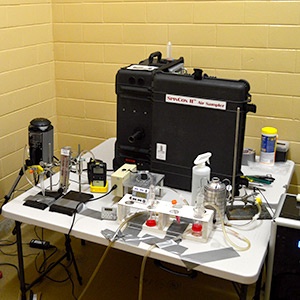Being able to detect infectious influenza viruses and coronaviruses in the air can reveal how far virus-containing particles may travel, how deeply they enter the human or animal respiratory tract, and the most effective ways to limit exposures to them.
Researchers in the School of Public Health (SPH) and College of Veterinary Medicine (CVM) compared the ability of a range of existing samplers to detect and measure airborne influenza viruses accurately. Samplers are devices that use liquids, controlled airflow, filters, static electricity and other means to capture and measure particles in the air. The research team’s findings were recently published in the journal PLOS ONE.
The team experimentally generated droplets containing test viruses into the air in a carefully-controlled test facility and measured the amounts and concentrations of infectious virus and viral RNA with each of the samplers.
The study found:
- Higher quantities of viruses were detected by samplers that processed higher volumes of air.
- Surprisingly, though, samplers that processed less air generally measured more accurate airborne concentrations of infectious virus and viral RNA than the higher-flow samplers.

The researchers concluded that to detect and assess airborne viruses, a two-sampler approach may be necessary: a high-flow sampler to detect the virus and a lower-flow sampler to measure airborne virus concentrations.
“This research helps us learn how to better measure airborne viruses not only in animal agriculture settings, but also in places like healthcare facilities and mass transit vehicles,” said study lead Peter Raynor, a professor in SPH. “Ultimately, it will help us understand the relative importance of droplet and airborne transmission of viruses during future outbreaks and pandemics. While this research focused on influenza viruses to which workers in animal agriculture may be exposed, we believe the findings also apply to many other viruses, such as SARS-CoV-2, the virus that causes COVID-19.”
Raynor says that he and the research team have additional data to publish on other samplers along with some comparisons of samplers in the real world. They are using the results of this study to design a better sampler than current ones to measure concentrations and sizes of virus-containing particles.

